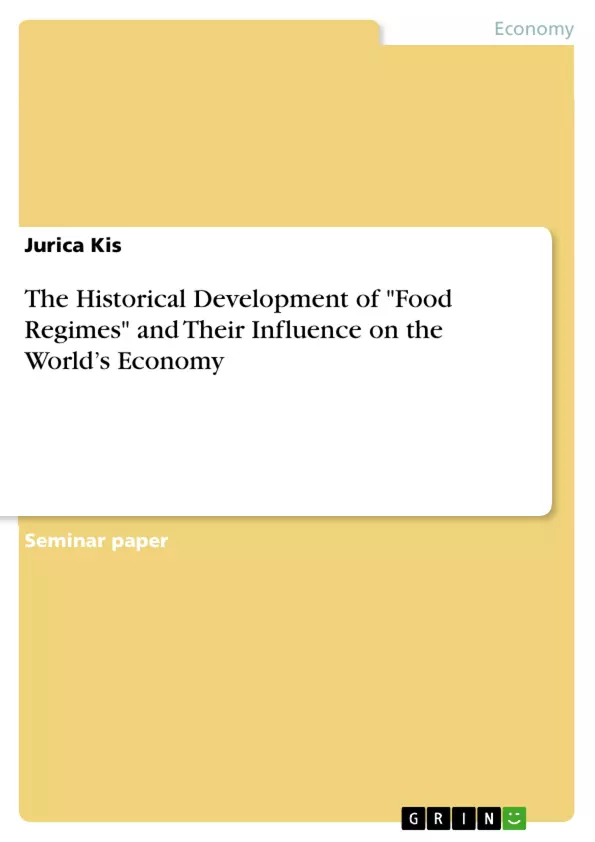The following paper deals with the historical development of ‘Food Regimes’ by defining this phenomena in a theoretical approach, illustrating the characteristics of the several Food Regimes, and ending with a comparison of the three Food
Regimes, their influence on the world’s economy and critics of these organizational concept. This chapter concentrates on the theoretical approach of Food Regimes. Therefore it takes first a closer look on the general definition of regimes and concentrates then on the definition of Food Regimes. “Regimes are social institutions governing the actions of those involved in specifiable activities or sets of activities.” And furthermore “they are practices consisting of recognized roles linked together by clusters of rules or conventions governing
relations among the occupants of these roles” (Young 1989: 12 – 13). This definition will help to understand the topic about ‘Food Regimes’, as the theory of regimes is one of the main aspects to analyze the historical development of this
special kind of regimes.
Inhaltsverzeichnis (Table of Contents)
- Theoretical Approach
- Definition Regimes
- Definition Food Regimes
- Historical Development of the Food Regimes
- The First Food Regime
- Characteristics
- The Second Food Regime
- Characteristics
- The Norms
- Foundation of Food Organizations
Zielsetzung und Themenschwerpunkte (Objectives and Key Themes)
This paper examines the historical development of 'Food Regimes', providing a theoretical framework, exploring the characteristics of various Food Regimes, and concluding with a comparative analysis of the three Food Regimes, their influence on the global economy, and critiques of these organizational concepts.
- Defining and analyzing the concept of Food Regimes as a historical phenomenon.
- Exploring the characteristics of different Food Regimes, including their emergence and collapse.
- Examining the influence of Food Regimes on global economic development.
- Addressing critiques of the Food Regime concept.
- Analyzing the role of international organizations and government agencies in shaping food regimes.
Zusammenfassung der Kapitel (Chapter Summaries)
Theoretical Approach
This chapter introduces the theoretical framework of Food Regimes. It begins by defining regimes in general as social institutions that govern specific activities. It then focuses on the definition of Food Regimes, highlighting their historical significance and the role of international food business in shaping them.
Historical Development of the Food Regimes
This chapter delves into the historical development of Food Regimes, examining their specific characteristics and the reasons for their collapse. It focuses on the First Food Regime, which existed between 1870 and 1914, and is also known as the “diasporic-colonial Food Regime.” This chapter explores the characteristics of this regime, emphasizing its reliance on an expansive form of capitalist development based on increased land and labor resources.
Schlüsselwörter (Keywords)
This paper focuses on the key concepts of Food Regimes, historical development, international food business, global economy, and critiques of organizational concepts. It explores various regimes, including the First Food Regime, and examines their characteristics, influences, and the role of international organizations. The paper also discusses the significance of food trade, food aid, and rural development in shaping global food systems.
- Quote paper
- Jurica Kis (Author), 2008, The Historical Development of "Food Regimes" and Their Influence on the World’s Economy, Munich, GRIN Verlag, https://www.grin.com/document/118514



